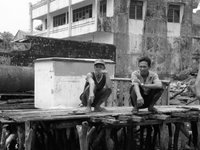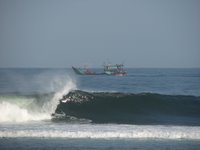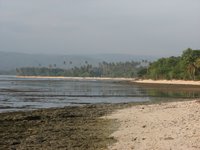Nias

The Road to Nias
September 5, 2006
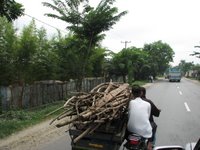 The journey to Nias Island off the west coast of Sumatra is notorious, arguably the most brutal in the surf travel world (well, at least in Indo). Ours was to be even rougher, due to the fact that we were starting in the southern tip of Sumatra. Our choices were to travel overland to Sibolga (which would involve over 40 hours of bus travel, where the Indonesians were rumored to smoke constantly inside the air conditioned bus), or return to Jakarta and take as many flights as possible. We chose the latter.
The journey to Nias Island off the west coast of Sumatra is notorious, arguably the most brutal in the surf travel world (well, at least in Indo). Ours was to be even rougher, due to the fact that we were starting in the southern tip of Sumatra. Our choices were to travel overland to Sibolga (which would involve over 40 hours of bus travel, where the Indonesians were rumored to smoke constantly inside the air conditioned bus), or return to Jakarta and take as many flights as possible. We chose the latter.Krui to Bandar Lampung
1:00 AM
Our bemo driver shows up, he’s about the size of an unemployed tropical Christmas elf. He was so small that his seat was pulled all the way forward, and I kid you not, he had wood blocks tied to the bottom of his shoes so that he could reach the pedals. Our driver took different route over the coastal mountains. The "broken" road was a shorter distance, but unpaved and rocky. Somewhere near the summit, our driver decided to pull over for a catnap. We figured that we'd let him sleep for a while, it was better than him crashing from lack of sleep. Besides, we could finally get some sleep without being thrashed about on the bumps. We slept for at least an hour, the Sumatran coastal forest hissing, buzzing, with strange creatures rustling somewhere in the distance.
9:00 AM
We catch the first available flight to Jakarta and arrive an hour later.
At the Jakarta airport I watched the baggage while Adam searched for flights to Medan, a test of patience and will. We managed to book a flight to Medan leaving 3:00 PM.

6:00 PM
We arrive in Medan, the largest city in Sumatra, located on its eastern seaboard. We checked into a four-star hotel popular with Chinese and Japanese businessmen, setting us back $40. In the lobby we met a Brazilian man by the name of Carlos. He had been struggling for several days to fly into Nias, but gave up and was leaving on an overland journey. He explained to us that he had declared bankruptcy back home due to the failure of his business. Perfect time for a surf trip, he explained, "What's a little fart once you've already shit your pants?!"
6:00 AM Following Day
We charged blindly to the airport with all of our belongings, hoping to find a flight to Nias. One of the flights was full; the other airline was experiencing mechanical problems.
To our good fortune Adam was approached by a man named Darwin who told us we could charter a bemo from him, overland to Sibolga, for $80. Only catch was that since he lacked an official airport taxi permit, we had to meet him outside the airport. So we drag our stuff all the way to the other side, six terminals down, only to be blocked by a fence and a mob like seen where the airport met the public streets. We had nowhere to go, and we couldn’t just step into traffic, so Adam went to fetch Darwin While I guarded the stuff. I was in the middle of a huge crowd who was waiting for arrivals, cars honking, people grabbing at me, a hectic but typical indo scene. It was hen that I realized I was adjusted to the Indo culture, no problems, no stress, I was completely comfortable. Before I new it we had our boards strapped on the roof and we were on our way to the west coast.
Transecting Sumatra

After four hours of driving we began to climb the huge mountain range that runs down the center of Sumatra. We were heading into the land of the Batak who were once the most warlike people of Sumatra....practicing ritual cannibalism until 1816. The Dutch converted the Batak people to Christianity, and we spotted Christian churches everywhere. The houses are a trip, with huge saddleback roofs called tobo. Soon we reached Danau Toba, Asia's largest fresh water lake. Tall mountain peaks covered in cloud forest surrounded this majestic lake.


Six hours into the journey we began to descend the western slope toward the coastal plane. The forest grew thicker, while the road grew narrow, hair-pin turns and an occasional mudslide blocking the way. Our bemo driver, who up until this point was a safe and courteous, started playing a cat and mouse game with the bemo in front of us, risking driving off the edge into bottomless ravines, just to pass and spite the other driver (best tactic was just to close your eyes and not try and pay attention). After passing through some crazy one lane tunnels, with dirt bottom and raw rock above, lacking any reinforcements, we saw the lights of Sibolga below. Our driver was on his cell phone, and when we reached the city limit, a man was waiting on a motorcycle for us.
Sibolga
According to our guidebook, Sibolga was notorious for its con artists and thieves, whose favorite victims were traveling surfers on their way to Nias, "weighed down by heavy board bags." Adding this to other rumors we heard from fellow travelers, our guard was up.
So our driver follows the man on the motorcycle, turning several times before we stopped in front of a photocopy place.
Monte, AKA "The Wolf",
as serious as he looks.
 His name was Monte, and he introduced himself as our guide and quickly laid out what we needed to do. This man was pure business. The way the man worked was impressive. He was fast, efficient, he reminded me of the "wolf", straight out of Pulp Fiction. Apparently, it was too late to buy ferry tickets, but Monte had his connections and he was going to extradite the whole process for us.
His name was Monte, and he introduced himself as our guide and quickly laid out what we needed to do. This man was pure business. The way the man worked was impressive. He was fast, efficient, he reminded me of the "wolf", straight out of Pulp Fiction. Apparently, it was too late to buy ferry tickets, but Monte had his connections and he was going to extradite the whole process for us.First we made copies of our passports for the ferry captain. Then we rushed to use the ATM and get a few beers, and off we followed him on his motorcycle to the harbor. He got us waved right through security, had a guy waiting for us on the dock with a luggage cart who loaded it up and we were off to the boat. Monte's boys got our bags on board, while he took us to our small little cabin and introduced us to the captain.
The wooden vessel looked seaworthy, sort of. The main deck was filled with about 100 Niasian people, who sat on the floor. Very small in stature, no one taller than five feet, they all looked at us with curious eyes.
"Hey mister, you want buy?"
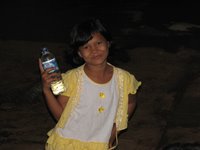 Two months earlier in Madagascar, we read a newspaper article that a ferry bound for Nias sank. Monte verified the story, explaining that almost everyone died (the majority of Indonesian can not swim). Before the ferry captains would pack in as many passengers as possible, but now he Indonesian government was enforcing a strict policy, allowing a maximum of 100 passengers.
Two months earlier in Madagascar, we read a newspaper article that a ferry bound for Nias sank. Monte verified the story, explaining that almost everyone died (the majority of Indonesian can not swim). Before the ferry captains would pack in as many passengers as possible, but now he Indonesian government was enforcing a strict policy, allowing a maximum of 100 passengers. Our cabin had four small bunks and three small holes looking out towards the water below. They were just large enough for us to fit through incase we needed to abandon ship. Before Monte departed he told us about his sister’s loseman (hotel) in Sorake, and told us to make sure and lock our cabin doors that night.
Our cabin had four small bunks and three small holes looking out towards the water below. They were just large enough for us to fit through incase we needed to abandon ship. Before Monte departed he told us about his sister’s loseman (hotel) in Sorake, and told us to make sure and lock our cabin doors that night."Come on Monte, give us a smile!"

 The door didn't lock, so we did our best to barricade it with our baggage. We bought some last minute supplies from the girls below on the dock, namely a bottle of whiskey flavored, watered down poison, and a pack of kreteks. With our tunes on and bad liquor in our bellies, we managed to fall asleep. In the middle of the night I opened my eyes to see a giant cockroach staring me down, an inch away from my face. I let out a scream like a little girl waking Adam up. We fell back into dreamland as a heavy tropical down pour began thoughts of capsizing increased with the winds. At about 4 in the morning we were rudely awakened, along with the rest of the ship, to crazy indo-electro-club music (200 beats/minute) at full volume. An hour later we pulled into the Gunung Sitoli harbor. The cabin door across the galley opened and there stood the Brazilian man Carlos who we'd met in Medan (the guy who doesn't mind farting after he shits his pants).
The door didn't lock, so we did our best to barricade it with our baggage. We bought some last minute supplies from the girls below on the dock, namely a bottle of whiskey flavored, watered down poison, and a pack of kreteks. With our tunes on and bad liquor in our bellies, we managed to fall asleep. In the middle of the night I opened my eyes to see a giant cockroach staring me down, an inch away from my face. I let out a scream like a little girl waking Adam up. We fell back into dreamland as a heavy tropical down pour began thoughts of capsizing increased with the winds. At about 4 in the morning we were rudely awakened, along with the rest of the ship, to crazy indo-electro-club music (200 beats/minute) at full volume. An hour later we pulled into the Gunung Sitoli harbor. The cabin door across the galley opened and there stood the Brazilian man Carlos who we'd met in Medan (the guy who doesn't mind farting after he shits his pants).We decided to join forces and hired a bemo together for the 4 hour drive to Sorake beach.
 Dozing in and out of sleep, the drive south revealed Tsunami damage and reconstruction efforts the entire way. I was blown away by the tropical beauty; the coconut palms on the beaches were denser than anywhere I had ever seen.
Dozing in and out of sleep, the drive south revealed Tsunami damage and reconstruction efforts the entire way. I was blown away by the tropical beauty; the coconut palms on the beaches were denser than anywhere I had ever seen.Finally we reached the fabled Sorake beach and took up residence at a losemen run by relatives of Monte. The place was run by a young guy named Sakome and his wife Linda, along with his older brother Akela (who was educated in Europe and was involved in the reconstruction effort) and his wife Anna.
 We settled in, grabbed our boards and headed out for a surf I'd been dreaming of for years. Walking up the point past destroyed buildings and clusters of losemen filled with starving Aussies, we paddled out through the keyhole into surf bliss. It was 6 foot, offshore, and the crowd was mellow. It was like a dream
We settled in, grabbed our boards and headed out for a surf I'd been dreaming of for years. Walking up the point past destroyed buildings and clusters of losemen filled with starving Aussies, we paddled out through the keyhole into surf bliss. It was 6 foot, offshore, and the crowd was mellow. It was like a dream


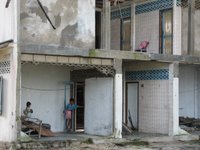 Tsunami Stories
Tsunami StoriesOn March 28, 2005 an earthquake measuring 8.8 on the Richter scale struck Nias. Sakome was inside of his house during the quake along with his family. When the tremor stopped, Salome assessed the situation, he and his family went outside, and everyone was safe. Suddenly the water began to drain off the reef, giving warning of what was to come. His wife Linda was 8 months pregnant at the time, and luckily two rather strong Englishmen staying at the hotel were able to carry her.

The family all headed towards higher ground when the first wave Tsunami hit them from behind, dragging them across the rice fields. Everyone struggled to hold their heads above water, and luckily everyone survived minus some scratches and bruises. In fact, the entire village survived the earthquake and tsunami.

Most of the damage to the buildings occurred as the water receded back to sea. The family lost two buildings and two automobiles. One of the buildings completely disappeared, leaving only a toilet and bathroom floor as evidence of its existence.
This surf spot no longer works since
the earthquake raised the reef more
than one meter.

Across the street, Akela lost his bar, the Toho. Apparently it had the best food and the only nightlife in Sorake. We could've used some nightlife and good food.
Akela and what's Left of Toho.Check out the high water mark
in photo two.


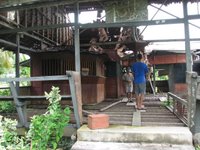




We were living comfortably on the top floor of a water front building with a perfect view of the line-up. We got a week of insane surf, three days being large and in charge. On the big day, I took some beatings, but pulled into some of my meanest right hand shacks ever. It was all down hill from there.
Sickness
That night I ate some shitty spaghetti carbon era made with sweet condensed milk and something just wasn’t right. To begin with, sanitation practices in Nias are low, and the quality of food in notoriously poor. That night I developed a fever, chills and sweats.
It sucks getting sick when you travel especially on the equator with 100% humidity. You start to get negative about everything, your trip, what the hell you're doing here, etc. But you know that as soon as you're better your spirits will be high again and you'll be back on track, so you just have to ride it out the best you can.
Adam, being the good travel partner he is, brought me water, ibuprofen, whatever I needed, but kept the conversation to a minimum, because when you're that sick, the last thing you want to do is talk. I waited a day to make sure it was a gastro-bacterial infection. Once the signs were there, I started my dose of Ciprofloxin. The fever broke that night, and by the next morning I was 75%, and within 36 I was 100% and surfing again. As soon as I was better Adam fell ill, with the same symptoms, ciprofloxin being his godsend.
Def Con Index
Since a traveler’s over all health can usually be measured by the quality of his stools, we developed an index to describe the quality of our stools using the Def Con System (in our case Def Con is short for Defecation Condition)
Def Con 5: Solid and compact, you are so proud of this stool that you would like to show your friends.
Def Con 4: Average, everyday healthy stool.
Def Con 3: Below average, still solid but with a semi- soft serve consistency.
Def Con 2: Can be compared to soft serve ice cream.
Def Con 1: A liquid consistency, but still evidence of some solid matter.
Def con 0: Pure liquid. If accompanied by stomach pain and fever, consult doctor or self medicate with favorite antibiotic.
Tropical Depression

Rain, rain, wind, and more rain. It was as wet and soggy as an Alabama swamp. It was the beginning of the rainy season, but according to the locals it was unusual for so much rain to fall in September. At first it would just rain at night, then in the mornings. Before knew it was raining nonstop. The runoff from the rivers turned the clear waters of the bay a chocolate brown. Sewage and septic systems, damaged from the earthquake, would join the village runoff, emptying directly into the line-up. The surf was still decent, glassy but a little jumbled up. We donned our earplugs and did our best not to swallow any chocolate milk.
Bad Food
According to our guidebook, "Sorake beach food is consistently poor." That's an understatement. The first week you can handle it no problem, but after that it’s a test of one's will and strength of one's digestive system. We tried to branch out and eat at other losemen but it was the same story, same menu, same poor sanitation, and same lack of love for the visiting surfer.
Boredom

If you are not surfing, there is absolutely nothing to do except read, read, and read. Luckily some enterprising young men in the surrounding villages became book salesmen and would visit us daily, selling or renting us reading materials at premium prices. I was reading a book called Powder Marching, about an English drug smuggler who was thrown into San Juan Prison in Bolivia. Here you could buy your own "apartment" cell that was quite comfortable. Well our little cell started to feel like a prison apartment, but I think the prison food must have been better than Sorake beach.
Getting Outta Dodge
With the surf forecast for the next week being very bleak, we knew it was time to make our move. Our friend Carlos gave us a book about Northern Sumatra that was to change the course of our trip. It contained invaluable information about the outer islands of Sumatra. We chose a small satellite archipelago of Nias where we were sure to score uncrowded waves. Choosing our destination was the easy part, getting there was going to be a whole lot tougher.
Soon we were going to be free birds once again. 
The first thing you must understand about Indonesia is that nothing goes smoothly, especially negotiating transportation. Each day we traveled to a port town known as Teluk Delam to organize a boat. The boat headed out to the outer islands twice a week, but with no set schedule. On top of this, the bad weather caused cancellations day after day. We were always told the same thing, "maybe tomorrow." We soon asked our land lord Sakome to help us out with organizing a boat. The man was well connected and could make it happen if he wanted to. But after a few days we realized he was giving us the runaround. If we left, he would loose out on our money. We gave him an ultimatum: hook us up with a boat, or we're leaving back to Sibolga. That night, like magic, he found a fishing vessel that was leaving the next day and we were on it.
Local kids take advantage of a post
apocalyptic playground.
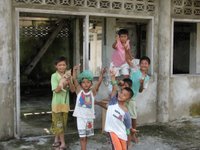

Teluk Delam


The scenic port town of "Te-YUCK Delam", with its mud streets, piles of rotting garbage, half dead mange dogs, and cold, stale Padang food on display, is on my list of the top 3 gnarliest towns on earth.


After catching a ride on the top of a local bus, we found our way to the "harbor" with its "docks" made up from branches stuck into the mud bottom of the bay and odd pieces of lumber. Our fishing vessel looked like your typical; indo variety but appeared seaworthy enough. We met a kid from Asu Island named Farno who was a passenger along with us. He was on his way to Batu Island to look for work at a new surf camp that was being built.

We ran back into town to grab a few last minute supplies and call our parents to let them know where we were going and that we would be incommunicado for at least three weeks. As we left the safety of the bay, the feeling of adventure and excitement of the unknown returned. I inhaled the salty air deeply, and took it all in.


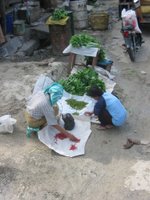
Goodbye Teluk Delam!!
